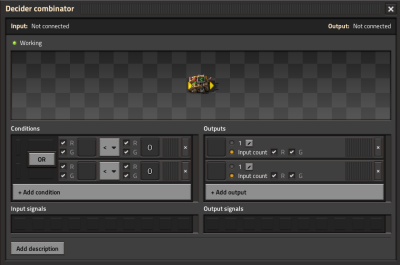Decider combinator
| Decider combinator |
|
Recipe |
|||||||||||||
| ++ → | |||||||||||||
|
Total raw |
|||||||||||||
| ++ | |||||||||||||
|
Map color |
|||||||||||||
|
Health |
|
||||||||||||
|
Stack size |
50 |
||||||||||||
|
50 (1 stack) |
|||||||||||||
|
Energy consumption |
1 kw (electric) |
||||||||||||
|
Mining time |
0.1 |
||||||||||||
|
Prototype type |
|||||||||||||
|
Internal name |
decider-combinator |
||||||||||||
|
Required technologies |
|||||||||||||
|
Produced by |
|||||||||||||
|
Consumed by |
|||||||||||||
The decider combinator is part of the circuit network and one of four types of combinators available in the game (with the other three being the constant combinator, arithmetic combinator, and selector combinator). It is used to make comparisons of signals on the network.
Function
The decider combinator allows specifying a list of conditions on the left side of the GUI and a list of outputs on the right side of the GUI. Generally whenever the conditions are satisfied the outputs are activated.
A condition consists of a "first" input signal, a comparison (>, <, =, >=, <=, !=), and a "second" input signal or constant. Additionally, for each input signal the input wires to read the signal from can be specified. If both red and green are checked, the input values are summed.
If more than one condition is added, it is possible to change the connection of those using the logical operators AND and OR. An AND condition will result in true if all terms are true. An OR condition will return true if at least one of the terms is true.
Each output has the option to specify a constant value, or to take the input count from specified wires. If both red and green are checked, the input values are summed.
The decider combinator can handle logic signals. The following table shows how different combinations of logic signals can be used:
| Input → | No Each condition | Each condition present |
|---|---|---|
| ↓ Output | ||
| Everything | Evaluated on every signal that has a non-zero sum on the selected wires† | - |
| Anything | Evaluated on one signal that has a non-zero sum on the selected wires† | Evaluated on one signal that passes the Each conditions |
| Each | - | Evaluated on Each passing signal |
| Specific signal | Evaluated on the specified signal | Evaluated on Each passing signal, but the results are output on the specified signal instead |
† wires can be selected even if a constant value is specified
With both the arithmetic and decider combinator, there is one tick (60th of a second) of latency before the output signal is ready to be used as an input into a circuit network.
History
- 2.0.36:
- Decider combinator output constant can be changed.
- 2.0.7:
- Received a UI overhaul.
- Now displays input signals when configuring combinators.
- Signals used by combinators can now be filtered between red, green, or both.
- Multiple and/or operations can be performed in a single decider combinator.
- Received a UI overhaul.
- 1.1.13:
- Decider combinator can output an Anything signal, which returns exactly one matching signal.
- 0.15.0:
- Added additional operators to the Decider Combinator and Circuit Conditions.
- 0.13.0:
- Connected wires are highlighted when hovering over a combinator connected to the circuit network.
- Combinators show input and output in alt mode.
- More virtual signals for combinators.
- Decider combinator "input count" option makes the combinator copy the count of the specified output signal from the input signals, instead of copying the count from the condition.
- New combinator graphics.
- 0.12.5:
- Combinators now emit light.
- 0.12.2:
- Combinators no longer turn off when no wires are connected.
- 0.12.0:
- Introduced

